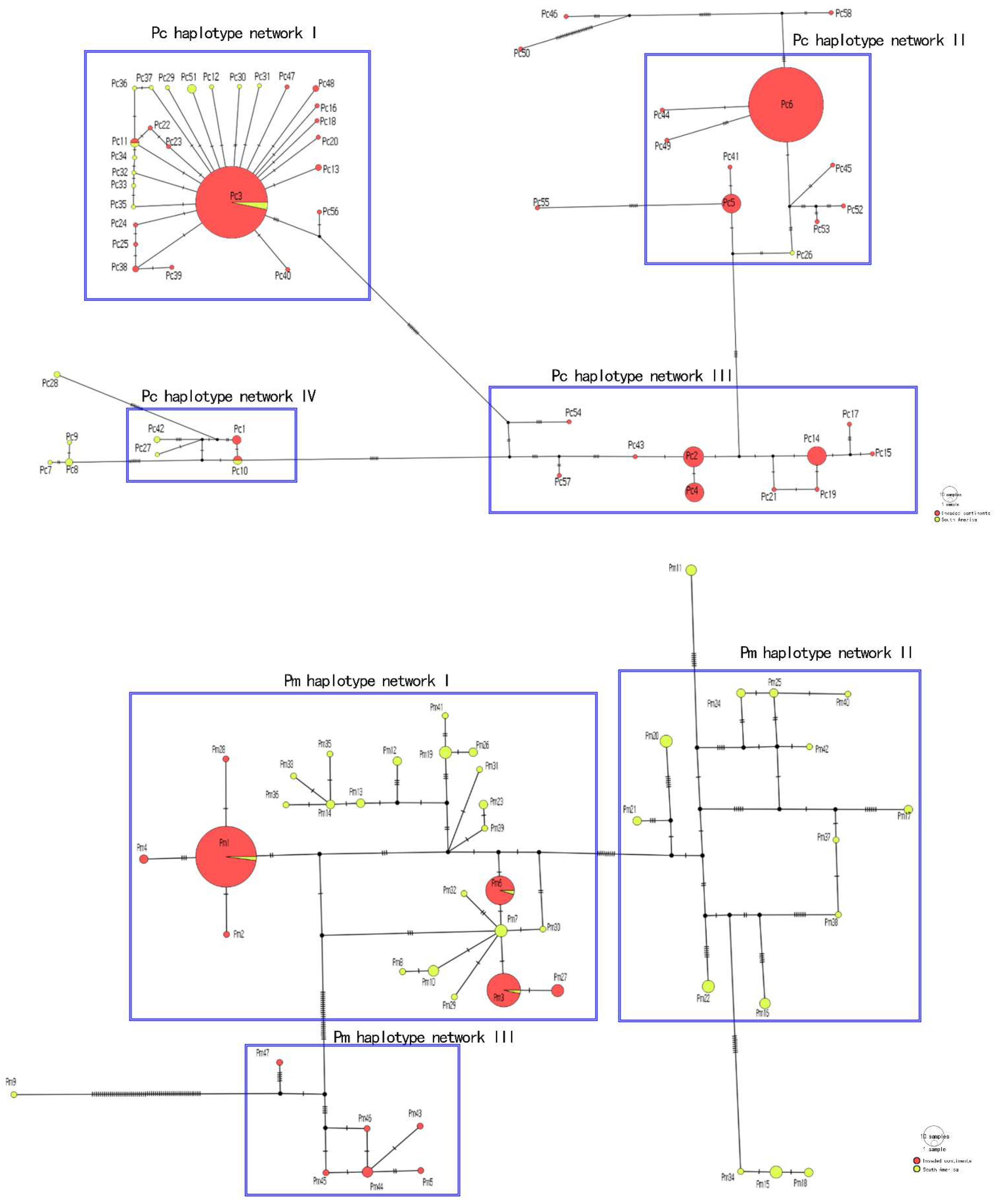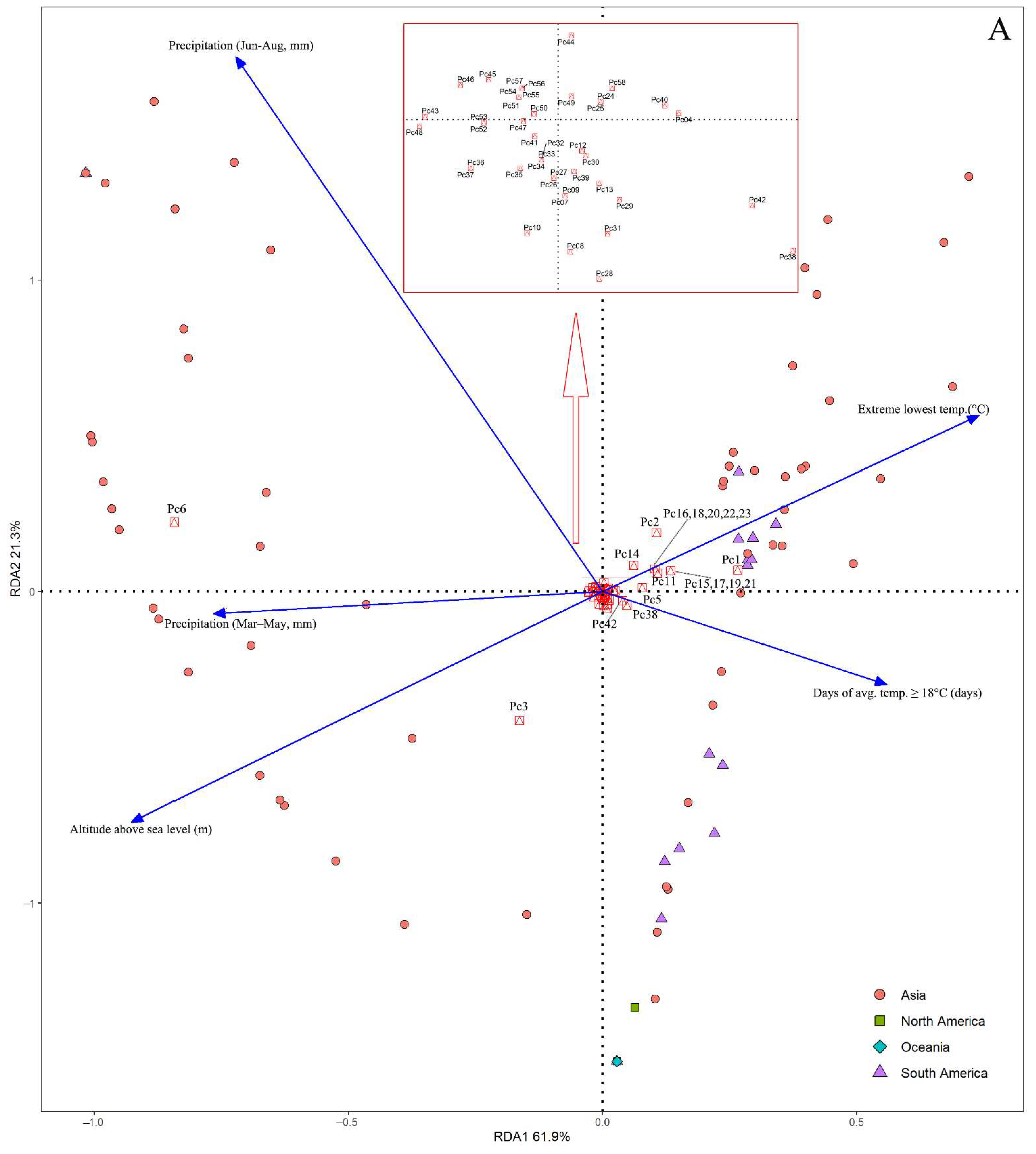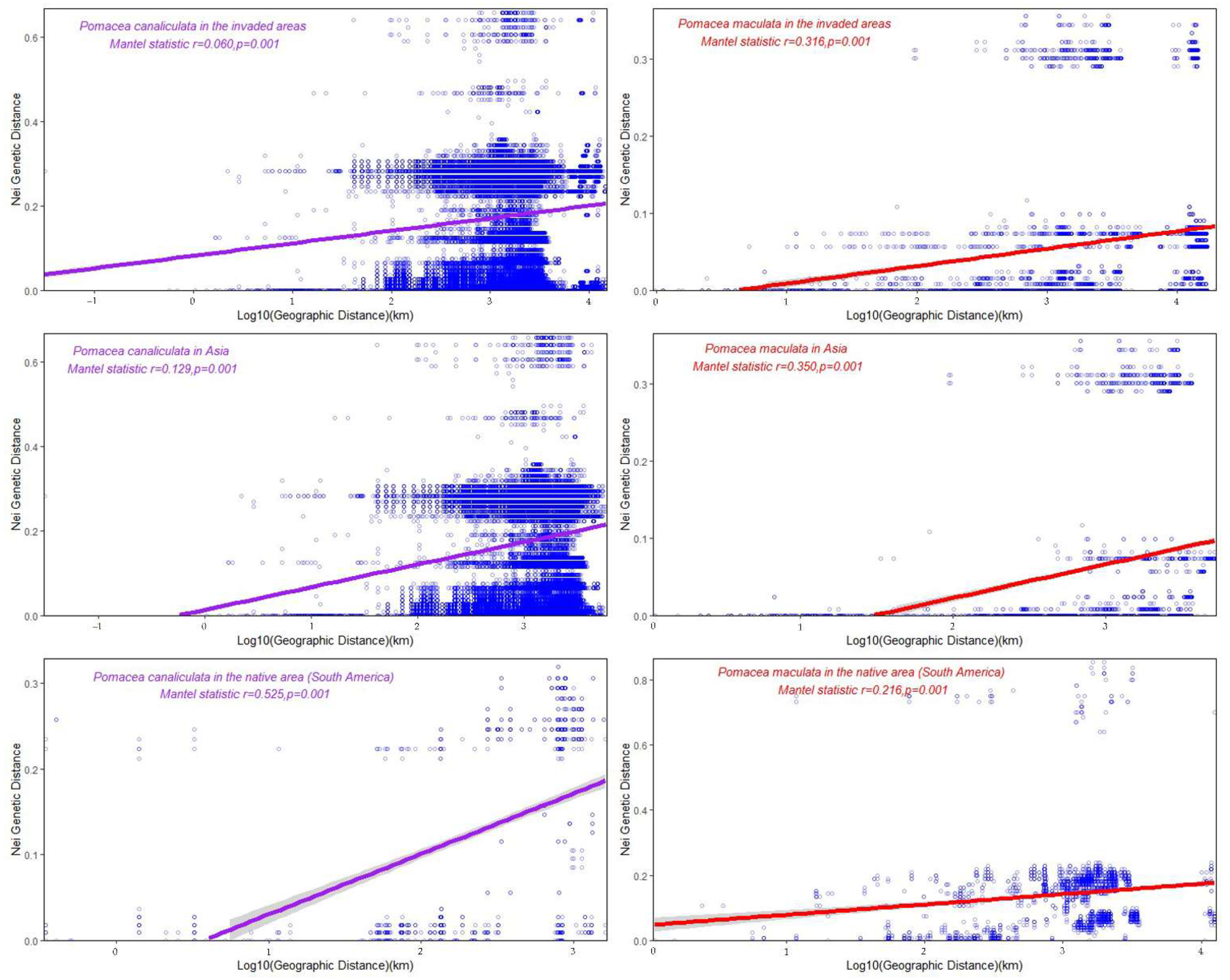Genetic Diversity of Two Globally Invasive Snails in Asia and Americas in Relation with Agricultural Habitats and Climate Factors
Abstract
1. Introduction
2. Materials and Methods
2.1. Sample Collection, Sequencing and Dataset Construction
2.2. Analysis of Genetic Differentiation
3. Results
3.1. Distribution and Divergence of Sequences
3.2. Correlation Analysis, Neutrality Test and Mismatch Analysis
3.3. Haplotype and RDA Analysis of P. canaliculata and P. maculata
3.4. Genetic Structure and Isolation by Distance of P. canaliculata and P. maculata
4. Discussion
4.1. Genetic Diversity and Population History
4.2. Haplotype Network and Its Relation to Climate Factors
4.3. Genetic Differentiation and Isolation by Distance
5. Conclusions
Supplementary Materials
Author Contributions
Funding
Institutional Review Board Statement
Data Availability Statement
Acknowledgments
Conflicts of Interest
References
- Sherpa, S.; Despres, L. The evolutionary dynamics of biological invasions: A multi-approach perspective. Evol. Appl. 2021, 14, 1463–1484. [Google Scholar] [CrossRef] [PubMed]
- Hofstadter, D.F.; Kryshak, N.F.; Wood, C.M.; Dotters, B.P.; Roberts, K.N.; Kelly, K.G.; Keane, J.J.; Sawyer, S.C.; Shaklee, P.A.; Kramer, H.A.; et al. Arresting the spread of invasive species in continental systems. Front. Ecol. Environ. 2022, 20, 278–284. [Google Scholar] [CrossRef]
- Yarra, A.N.; Magoulick, D.D. Modelling effects of invasive species and drought on crayfish extinction risk and population dynamics. Aquat. Conserv. 2019, 29, 1–11. [Google Scholar] [CrossRef]
- Kotov, A.A.; Karabanov, D.P.; Van Damme, K. Non-indigenous Cladocera (Crustacea: Branchiopoda): From a few notorious cases to a potential global faunal mixing in aquatic ecosystems. Water 2022, 14, 2806. [Google Scholar] [CrossRef]
- Azmi, W.A.; Khoo, S.C.; Ng, L.C.; Baharuddin, N.; Aziz, A.A.; Ma, N.L. The current trend in biological control approaches in the mitigation of golden apple snail Pomacea spp. Biol. Control. 2022, 175, 105060. [Google Scholar] [CrossRef]
- Naylor, R. Invasions in agriculture: Assessing the cost of the golden apple snail in Asia. Ambio 1996, 25, 443–448. [Google Scholar]
- Horgan, F.G. Ecology and management of apple snails in rice. In Rice Production Worldwide; Chauhan, B., Jabran, K., Mahajan, G., Eds.; Springer: Cham, Switzerland, 2017. [Google Scholar]
- Lowe, S.; Browne, M.; Boudjelas, S.; De Poorter, M. 100 of the World’s Worst Invasive Alien Species: A Selection from the Global Invasive Species Database; Invasive Species Specialist Group: Auckland, New Zealand, 2000. [Google Scholar]
- Horgan, F.G.; Stuart, A.M.; Kudavidanage, E.P. Impact of invasive apple snails on the functioning and services of natural and managed wetlands. Acta Oecol. 2014, 54, 90–100. [Google Scholar] [CrossRef]
- Gilioli, G.; Schrader, G.; Carlsson, N.; van Donk, E.; van Leeuwen, C.H.A.; Martín, P.R.; Pasquali, S.; Vilà, M.; Vosi, S. Environmental risk assessment for invasive alien species: A case study of apple snails affecting ecosystem services in Europe. Environ. Impact. Asses. 2017, 65, 1–11. [Google Scholar] [CrossRef]
- Xu, Y.X.; Wang, W.S.; Yao, J.M.; Yang, M.L.; Guo, Y.H.; Deng, Z.H.; Mao, Q.; Li, S.Z.; Duan, L.P. Comparative proteomics suggests the mode of action of a novel molluscicide against the invasive apple snail Pomacea canaliculata, intermediate host of Angiostrongylus cantonensis. Mol. Biochem. Parasit. 2022, 247, 111431. [Google Scholar] [CrossRef]
- Hayes, K.A.; Joshi, R.C.; Thiengo, S.C.; Cowie, R.H. Out of South America: Multiple origins of non-native apple snails in Asia. Divers. Distrib. 2008, 14, 701–712. [Google Scholar] [CrossRef]
- Rao, S.R.; Liew, T.S.; Yow, Y.Y.; Ratnayeke, S. Cryptic diversity: Two morphologically similar species of invasive apple snail in Peninsular Malaysia. PLoS ONE 2018, 13, e0196582. [Google Scholar]
- Luo, M.Z.; Zhao, B.L.; Zhang, J.E.; Qin, Z. Phenotypic plasticity of the invasive apple snail, Pomacea canaliculata, in China: A morphological differentiation analysis. Molluscan Res. 2022, 42, 146–157. [Google Scholar] [CrossRef]
- Yang, Q.Q.; Liu, S.W.; He, C.; Yu, X.P. Distribution and the origin of invasive apple snails, Pomacea canaliculata and P. maculata (Gastropoda: Ampullariidae) in China. Sci. Rep. 2018, 8, 1–8. [Google Scholar] [CrossRef] [PubMed]
- Andree, K.B.; López, M.A. Species identification from archived snail shells via genetic analysis: A method for DNA extraction from empty shells. Molluscan Res. 2013, 33, 1–5. [Google Scholar] [CrossRef]
- Yang, Q.Q.; Yu, X.P. A new species of apple snail in the genus Pomacea (Gastropoda: Caenogastropoda: Ampullariidae). Zool. Stud. 2019, 58, 13. [Google Scholar]
- Litsinger, J.A.; Estano, D.B. Management of the golden apple snail Pomacea canaliculata (Lamarck) in rice. Crop. Prot. 1993, 12, 363–370. [Google Scholar] [CrossRef]
- Yoshida, K.; Wada, T.; Matsukura, K.; Shiba, T. Potential overwintering areas of the alien apple snail, Pomacea canaliculata, in Japan at its northern distribution limit. Aquat. Invasions 2022, 17, 402–414. [Google Scholar] [CrossRef]
- Matsukura, K.; Izumi, Y.; Yoshida, K.; Wada, T. Cold tolerance of invasive freshwater snails, Pomacea canaliculata, P. maculata, and their hybrids helps explain their different distributions. Freshw. biol. 2016, 61, 80–87. [Google Scholar] [CrossRef]
- State Environmental Protection Administration and Chinese Academy of Sciences. Circular on Publishing the List of the First Batch of Alien Invasive Species in China. 2003. Available online: https://www.gov.cn/gongbao/content/2003/content_62285.htm (accessed on 18 October 2022).
- Rawlings, T.A.; Haye, K.A.; Cowie, R.H.; Collins, T.M. The identity, distribution, and impacts of non-native apple snails in the continental united states. BMC Evol. Biol. 2007, 7, 97. [Google Scholar] [CrossRef]
- Yang, Q.Q.; Liu, S.W.; He, C.; Cowie, R.H.; Yu, X.P.; Hayes, K.A. Invisible apple snail invasions: Importance of continued vigilance and rigorous taxonomic assessments. Pest. Manag. Sci. 2019, 75, 1277–1286. [Google Scholar] [CrossRef]
- Folmer, O.; Black, M.; Hoeh, W.; Lutz, R.; Vrijenhoek, R. DNA primers for amplification of mitochondrial cytochrome c oxidase subunit I from diverse metazoan invertebrates. Mol. Mar. Biol Biotech. 1994, 3, 294–299. [Google Scholar]
- Hall, T.A. BioEdit: A user-friendly biological sequence alignment editor and analysis program for Windows 95/98/NT. Nucleic Acids Symp. Ser. 1999, 41, 95–98. [Google Scholar]
- Matsukura, K.; Okuda, M.; Kubota, K.; Wada, T. Genetic divergence of the genus Pomacea (Gastropoda: Ampullariidae) distributed in Japan, and a simple molecular method to distinguish P. canaliculata and P. insularum. Appl. Entomol. Zool. 2008, 43, 535–540. [Google Scholar] [CrossRef]
- Hayes, K.A.; Cowie, R.H.; Thiengo, S.C. A global phylogeny of apple snails: Gondwanan origin, generic relationships, and the influence of outgroup choice (Caenogastropoda: Ampullariidae). Biol. J. Linn. Soc. 2009, 98, 61–76. [Google Scholar] [CrossRef]
- Song, H.M.; Hu, Y.C.; Wang, P.X.; Mou, X.D.; Li, X.H.; Wang, X.J.; Luo, J.R. Sequencing cytochrome oxidase subunit I of mitochondrial DNA and the taxonomic status of apple snails. Chin. J. Zool. 2010, 45, 1–7. [Google Scholar]
- Collier, K.J.; Demetras, N.J.; Duggan, I.C.; Johnston, T.M. Wild record of an apple snail in the Waikato river, Hamilton, New Zealand, and their incidence in freshwater aquaria. New Zealand Nat. Sci. 2011, 36, 1–9. [Google Scholar]
- Martin, C.W.; Baya, K.M.; Valentine, J.F. Establishment of the invasive island apple snail Pomacea insularum (gastropoda: Ampullaridae) and eradication efforts in mobile, Alabama, USA. Gulf Mex. Sci. 2012, 56, 30–38. [Google Scholar] [CrossRef]
- Matsukura, K.; Okuda, M.; Cazzaniga, N.J.; Wada, T. Genetic exchange between two freshwater apple snails, Pomacea canaliculata and Pomacea maculata invading east and southeast Asia. Biol. Invasions 2013, 15, 2039–2048. [Google Scholar] [CrossRef]
- Mu, H.; Sun, J.; Fang, L.; Luan, T.; Williams, G.A.; Cheung, S.G. Genetic basis of differential heat resistance between two species of congeneric freshwater snails: Insights from quantitative proteomics and base substitution rate analysis. J. Proteome Res. 2015, 14, 4296–4308. [Google Scholar] [CrossRef]
- Deaton, L.E.; Schmidt, W.; Leblanc, B.; Carter, J.; Mueck, K.; Merino, S. Physiology of the invasive apple snail Pomacea maculata: Tolerance to low temperatures. J. Shellfish Res. 2016, 35, 207–210. [Google Scholar] [CrossRef]
- Letelier, S.; Rebolledo, A.; Báez, P.; Fabres, A.; Soto-Acuña, S.; Jackson, D. The highly invasive freshwater apple snail pomacea canaliculata (Gastropoda: Ampullariidae) in northern Chile: Morphological and molecular confirmation. J. Zool. Stud. 2016, 3, 119–128. [Google Scholar]
- Yang, Q.Q.; Liu, S.W.; Ru, W.D.; Liu, G.F.; Yu, X.P. Molecular identification of invasive golden apple snails in Zhejiang Province based on DNA barcoding. Biodivers. Sci. 2016, 24, 341–350. (In Chinese) [Google Scholar]
- Bocxlaer, B.V.; Strong, E.E.; Richter, R.; Stelbrink, B.; Rintelen, T.V. Anatomical and genetic data reveal that rivularia heude, 1890 belongs to Viviparinae (Gastropoda: Viviparidae). Zool. J. Linn. Soc. Lond. 2017, 182, 1–23. [Google Scholar] [CrossRef]
- Perez, K.E.; Gamboa, V.G.; Schneider, C.M.; Burks, R.L. Resaca supports range expansion of invasive apple snails (Pomacea maculata perry, 1810; Caenogastropoda: Ampullariidae) to the Rio Grande Valley, Texas. Check List 2017, 13, 2134. [Google Scholar] [CrossRef][Green Version]
- Zhang, C.L.; Peng, J.; Ran, Z.; Zi, J.R.; Yang, Y.M. Genotyping and polymorphism analysis of cytochrome c oxidase subunit I gene of Pomacea canaliculata from Lincang City in Yunnan Province. Chin. J. Schisto. Control 2018, 30, 179–183. (In Chinese) [Google Scholar]
- Ng, T.H.; Tan, S.K.; Ahmad, A.; Joshi, R.C.; Wang, W.Y.; Tan, H.H. Not in the Least Concern: Anthropogenic influences on a South-east Asian apple snail Pila scutata (Ampullariidae). Oryx 2019, 53, 230–238. [Google Scholar] [CrossRef]
- Zhang, C.L.; Bao, X.Y.; Peng, J.; Zi, J.R.; Ran, Z.; Lu, N.; Yang, Y.M. Species identification of Pomacea snails in southwest Yunan Province based on COI gene polymorphism. Chin. J. Parasitol. Parasit. Dis. 2019, 37, 75–86. (In Chinese) [Google Scholar]
- Edgar, R.C. MUSCLE: Multiple sequence alignment with high accuracy and high throughput. Nucleic Acids Res. 2004, 32, 1792–1797. [Google Scholar] [CrossRef]
- Kumar, S.; Stecher, G.; Li, M.; Knyaz, C.; Tamura, K. MEGA X: Molecular evolutionary genetics analysis across computing platforms. Mol. Biol. Evol. 2018, 35, 1547–1549. [Google Scholar] [CrossRef]
- Librado, P.; Rozas, J. DnaSP v5: A software for comprehensive analysis of DNA polymorphism data. Bioinformatics 2009, 25, 1451–1452. [Google Scholar] [CrossRef]
- Excoffier, L.; Laval, G.; Schneider, S. Arlequin ver. 3.0: An integrated software package for population genetics data analysis. Evol. Bioinform. 2005, 1, 47–50. [Google Scholar] [CrossRef]
- R Core Team. R: A Language and Environment for Statistical Computing R Foundation for STATISTICAL Computing, Vienna, Austria. 2020. Available online: https://www.R-project.org/ (accessed on 18 October 2022).
- Paradis, E. Pegas: An R package for population genetics with an integrated-modular approach. Bioinformatics 2010, 26, 419–420. [Google Scholar] [CrossRef] [PubMed]
- Leigh, J.W.; Bryant, D. POPART: Full-feature software for haplotype network construction. Methods Ecol. Evol. 2015, 6, 1110–1116. [Google Scholar] [CrossRef]
- Wickham, H. Ggplot2: Elegant Graphics for Data Analysis, 2nd ed.; Springer-Verlag: New York, NY, USA, 2018. [Google Scholar]
- Bivand, R. The Maptool Package Version. 2019, 0.9-5. Available online: https://cran.r-project.org/src/contrib/Archive/maptools (accessed on 18 October 2022).
- Yu, G.C. The Scatterpie Package Version 0.1.2.2019. Available online: https://cran.r-project.org/web/packages/scatterpie/index.html (accessed on 18 October 2022).
- Oksanen, J.; Blanchet, F.G.; Friendly, M.; Kindt, R.; Legendre, P.; McGlinn, D.; Minchin, P.R.; O’Hara, R.B.; Simpson, G.L.; Solymos, P.; et al. Vegan: Community Ecology Package. R Package Version 2.5-6. 2019. Available online: https://CRAN.R-project.org/src/contrib/Archive/vegan (accessed on 18 October 2022).
- Slowikowski, K. Ggrepel: Automatically Position Non-Overlapping Text Labels with ‘Ggplot2’ R Package Version 0.8.2. 2020. Available online: https://CRAN.R-project.org/src/contrib/Archive/ggrepel (accessed on 18 October 2022).
- Lefort., V.; Longueville, J.E.; Gascuel, O. SMS: Smart Model Selection in PhyML. Mol. Biol. Evol. 2017, 34, 2422–2424. [Google Scholar] [CrossRef] [PubMed]
- Liao, P.C.; Kuo, D.C.; Lin, C.C.; Ho, K.C.; Lin, T.P.; Hwang, S.Y. Historical spatial range expansion and a very recent bottleneck of Cinnamomum kanehirae Hay. (Lauraceae) in Taiwan inferred from nuclear genes. BMC Evol. Biol. 2010, 10, 124. [Google Scholar] [CrossRef]
- López, B.; Zúñiga, G.; Mejiá, O. Phylogeographic structure in the apparent absence of barriers: A case study of the Mexican land snail Humboldtiana durangoensis (Pulmonata: Humboldtianidae). J. Molluscan Stud. 2019, 85, 244–252. [Google Scholar] [CrossRef]
- Zhang, Q.; Sun, C.; Zhu, Y.; Xu, N.; Liu, H. Genetic diversity and structure of the round-tailed paradise fish (Macropodus ocellatus): Implications for population management. Glob. Ecol. Conserv. 2020, 21, e00876. [Google Scholar] [CrossRef]
- Arekar, K.; Tiwari, N.; Sathyakumar, S.; Khaleel, M.; Karanth, P. Geography vs. past climate: The drivers of population genetic structure of the Himalayan langur. BMC Ecol. Evo. 2022, 22, 100. [Google Scholar] [CrossRef]
- Wang, Q.Q.; Shaheen, T.; Rong, L.; Tang, G.H. Phylogeography of walnut pest Atrijuglans hetaohei (Lepidoptera: Gelechioidea) reveals comprehensive influence of geographic barriers and human activities. J. Asia-Pac. Entomol. 2022, 25, 101962. [Google Scholar]
- Nehemia, A.; Ngendu, Y.; Kochzius, M. Genetic population structure of the mangrove snails Littoraria subvittata and L. pallescens in the Western Indian Ocean. J. Exp. Mar. Bio. Ecol. 2019, 514, 27–33. [Google Scholar] [CrossRef]
- Dumidae, A.; Janthu, P.; Subkrasae, C.; Polseela, R.; Mangkit, B.; Thanwisai, A.; Vitta, A. 2021. Population genetics analysis of a Pomacea snail (Gastropoda: Ampullariidae) in Thailand and its low infection by Angiostrongylus cantonensis. Zool. Stud. 2021, 60, 31. [Google Scholar]
- Valladares, M.A.; Fabres, A.A.; Collado, G.A.; Saez, P.A.; Mendez, M.A. Coping with dynamism: Phylogenetics and phylogeographic analyses reveal cryptic diversity in heleobia snails of Atacama Saltpan, Chile. Front. Ecol. Evol. 2022, 10, 869626. [Google Scholar] [CrossRef]







| Climate Factors | Indicators |
|---|---|
| Temperature | Avg. temp. (Dec–Feb) (°C), Avg. temp. (Mar–May) (°C), Avg. temp. (Jun–Aug) (°C), Avg. temp. (Sep–Nov) (°C), Avg. min. temp (°C), Avg. max. temp.(°C), Avg. temp.(°C), Avg. dew temp. (°C), Extreme lowest temp. (°C), Extreme highest temp. (°C), Days of avg. temp. ≤ 0 °C (days), Days of avg. temp. ≥ 18 °C (days), Days of avg. temp. ≥ 35 °C (days), Days of min. temp. ≤ 0 °C (days), Days of max. temp. ≥ 35 °C (days) |
| Precipitation | Total precipitation (mm), Precipitation (Dec–Feb) (mm), Precipitation (Mar–May) (mm), Precipitation (Jun–Aug) (mm), Precipitation (Sep–Nov) (mm), Max. single-day precipitation (mm), Precipitation days (days) |
| Altitude | Altitude above sea level (m) |
| Regions | Sequence Number | Nucleotide Diversity | Mean Pairwise Differences | Haplotype Diversity |
|---|---|---|---|---|
| P. canaliculata in the invaded continents | ||||
| Asia | 670 | 0.026 ± 0.013 | 14.829 ± 6.643 | 0.656 ± 0.012 |
| North America | 15 | 0.000 ± 0.000 | 0.248 ± 0.297 | 0.248 ± 0.131 |
| Oceania | 7 | 0.000 ± 0.000 | 0.000 ± 0.000 | 0.000 ± 0.000 |
| Total | 692 | 0.026 ± 0.013 | 14.902 ± 6.674 | 0.656 ± 0.012 |
| P. canaliculata in the native area | ||||
| South America | 38 | 0.024 ± 0.003 | 14.001 ± 6.423 | 0.933 ± 0.029 |
| P. maculata in the invaded continents | ||||
| Asia | 91 | 0.011 ± 0.003 | 6.722 ± 3.199 | 0.339 ± 0.065 |
| Europe | 8 | 0.000 ± 0.000 | 0.000 ± 0.000 | 0.000 ± 0.000 |
| North America | 63 | 0.006 ± 0.001 | 3.589 ± 1.847 | 0.699 ± 0.025 |
| Oceania | 1 | 0.000 ± 0.000 | 0.000 ± 0.000 | 0.000 ± 0.000 |
| Total | 163 | 0.012 ± 0.002 | 6.820 ± 2.612 | 0.600 ± 0.037 |
| P. maculata in the native area | ||||
| South America | 69 | 0.030 ± 0.003 | 17.443 ± 7.845 | 0.979 ± 0.006 |
| Species | Regions | Tajima’s D | Fu’s Fs | SSD | Rg |
|---|---|---|---|---|---|
| P. canaliculata | Invaded | 0.171 (0.640) | 6.496 (0.839) | 0.236 (0.001) | 0.378 (0.015) |
| Native | −0.011 (0.585) | −1.622 (0.313) | 0.043 (0.039) | 0.020 (0.317) | |
| P. maculata | Invaded | −0.734 (0.240) | −5.694 (0.929) | 0.131 (0.062) | 0.268 (0.078) |
| Native | −0.841 (0.236) | −4.181 (0.166) | 0.006 (0.386) | 0.004 (0.783) |
| Speices | Source of Variation | df | Sum of Squares | Variance Components | Percentage of Variation | p | Fixation Indices |
|---|---|---|---|---|---|---|---|
| P. canaliculata | Among continents | 3 | 444.638 | 2.8366 | 23.77 | 0.0039 | ΦCT = 0.2377 |
| Among populations within continent | 14 | 283.344 | 1.1483 | 9.62 | 0.0000 | ΦSC = 0.1262 | |
| Within populations | 712 | 5660.489 | 7.9501 | 66.61 | 0.0000 | ΦST = 0.3339 | |
| Total | 729 | 6383.471 | 11.9350 | ||||
| P. maculata | Among continents | 4 | 403.554 | 1.7008 | 23.29 | 0.0890 | ΦCT = 0.2329 |
| Among populations within continent | 8 | 121.715 | 1.0758 | 14.73 | 0.0020 | ΦSC = 0.1920 | |
| Within populations | 219 | 991.318 | 4.5266 | 61.98 | 0.0000 | ΦST = 0.3802 | |
| Total | 231 | 1516.587 | 7.3032 |
Publisher’s Note: MDPI stays neutral with regard to jurisdictional claims in published maps and institutional affiliations. |
© 2022 by the authors. Licensee MDPI, Basel, Switzerland. This article is an open access article distributed under the terms and conditions of the Creative Commons Attribution (CC BY) license (https://creativecommons.org/licenses/by/4.0/).
Share and Cite
Zhao, B.; Luo, M.; Zhang, J.; Liu, Y.; Deng, Z.; Gong, X. Genetic Diversity of Two Globally Invasive Snails in Asia and Americas in Relation with Agricultural Habitats and Climate Factors. Diversity 2022, 14, 1069. https://doi.org/10.3390/d14121069
Zhao B, Luo M, Zhang J, Liu Y, Deng Z, Gong X. Genetic Diversity of Two Globally Invasive Snails in Asia and Americas in Relation with Agricultural Habitats and Climate Factors. Diversity. 2022; 14(12):1069. https://doi.org/10.3390/d14121069
Chicago/Turabian StyleZhao, Benliang, Mingzhu Luo, Jiaen Zhang, Yiliang Liu, Zhixin Deng, and Xin Gong. 2022. "Genetic Diversity of Two Globally Invasive Snails in Asia and Americas in Relation with Agricultural Habitats and Climate Factors" Diversity 14, no. 12: 1069. https://doi.org/10.3390/d14121069
APA StyleZhao, B., Luo, M., Zhang, J., Liu, Y., Deng, Z., & Gong, X. (2022). Genetic Diversity of Two Globally Invasive Snails in Asia and Americas in Relation with Agricultural Habitats and Climate Factors. Diversity, 14(12), 1069. https://doi.org/10.3390/d14121069







